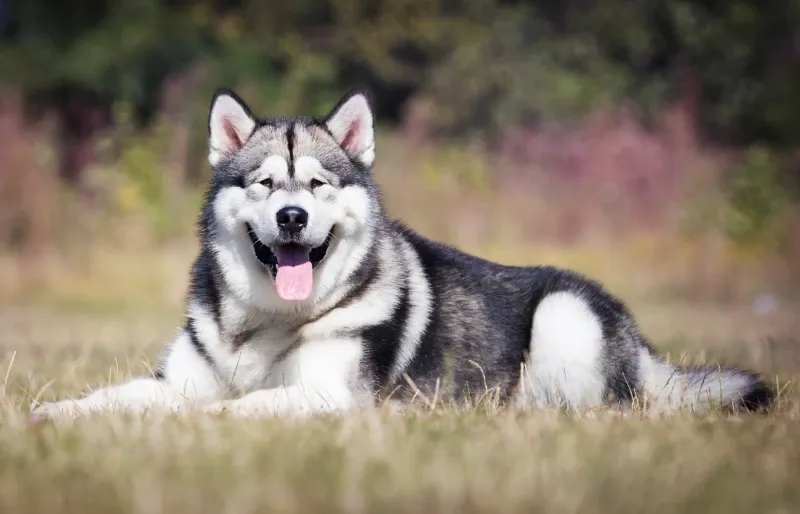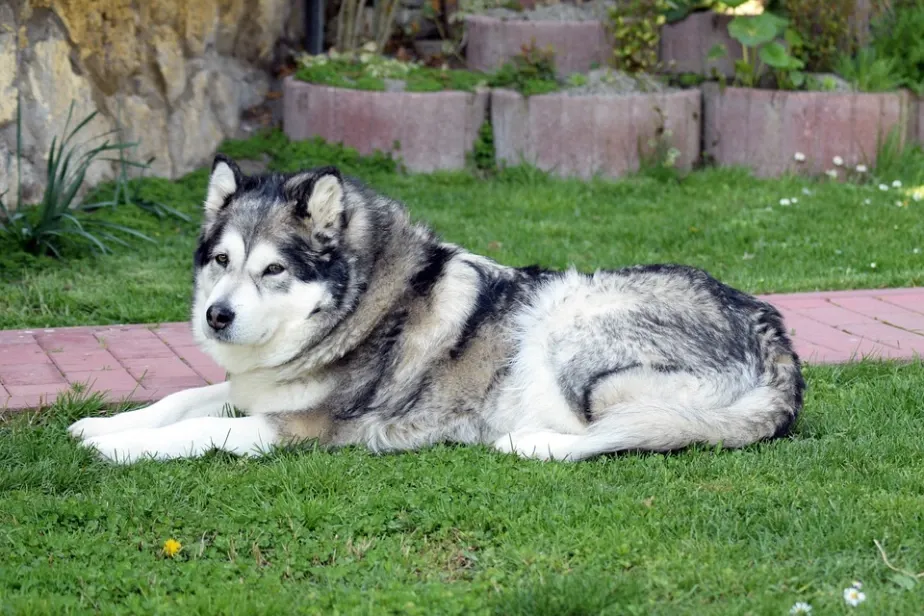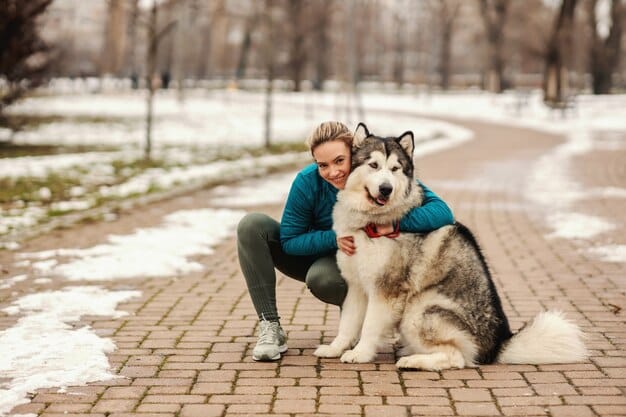The Alaskan Malamute is a large and powerful breed of dog that has been used for centuries by the indigenous people of Alaska for hauling heavy loads over long distances. They are known for their strength, endurance, and loyalty, and are often used today as working dogs in a variety of roles, including search and rescue, therapy, and as family pets.

One of the most common questions asked about the Alaskan Malamute is whether or not they are big dogs. The answer to this question is yes, the Alaskan Malamute is a large breed of dog, typically weighing between 75 and 100 pounds and standing 23 to 25 inches tall at the shoulder. However, it is important to note that size can vary depending on a number of factors, including genetics, diet, and exercise.
Despite their size, Alaskan Malamutes are known for their gentle and affectionate nature, and are often described as being great family pets. They are intelligent and highly trainable, and with proper socialization and training, can be excellent with children and other pets. However, due to their size and strength, it is important that they are properly trained and socialized from a young age to prevent any potential behavioral issues.

Breed Overview
Alaskan Malamutes are large and powerful dogs that were originally bred to haul heavy freight. They are one of the oldest Arctic sled dogs and are named after the native Inuit tribe called Mahlemuts who lived in the upper western part of Alaska.
Origin of Alaskan Malamutes
Alaskan Malamutes are believed to have descended from domesticated wolf-dogs that were bred by the Mahlemuts for hunting and transportation purposes. They were used by the tribe for hunting seals, polar bears, and other large game, as well as for hauling heavy loads across the rugged terrain of Alaska.
In the late 19th century, the breed was introduced to the United States and was recognized by the American Kennel Club in 1935. Today, Alaskan Malamutes are popular as family pets and are also used for sledding, weight pulling, and search and rescue operations.
Size and Weight Standards
Alaskan Malamutes are large and muscular dogs with a thick double coat that protects them from harsh Arctic winters. According to the American Kennel Club, male Alaskan Malamutes should weigh between 85 and 100 pounds and stand between 25 and 28 inches tall at the shoulder. Females should weigh between 75 and 90 pounds and stand between 23 and 26 inches tall at the shoulder.
While Alaskan Malamutes are not the largest breed of dog, they are certainly big and require a lot of space to move around and exercise. They are known for their strength and endurance, and are capable of pulling heavy loads over long distances. However, their size and strength also mean that they require a firm and consistent training regimen to ensure that they are well-behaved and obedient.
Physical Characteristics
Alaskan Malamutes are a large breed of dog that can weigh anywhere from 75 to 100 pounds. They have a sturdy and muscular build, which makes them well-suited for pulling heavy loads.
Coat and Color
Their thick double coat is one of their most distinctive features. The outer coat is coarse and long, while the undercoat is soft and dense. Alaskan Malamutes come in a variety of colors, including black, gray, sable, and red. Some dogs also have white markings on their chest, feet, and face.
Body Structure
Alaskan Malamutes have a broad and deep chest, which gives them a powerful appearance. Their legs are strong and well-muscled, allowing them to run and pull heavy loads easily. They also have a broad head with erect ears and a thick, bushy tail.
Overall, Alaskan Malamutes are a large and impressive breed of dog with a distinctive appearance. Their thick coat and muscular build make them well-suited for cold climates and outdoor activities.
Temperament and Behavior
Personality Traits
Alaskan Malamutes are known for their friendly and affectionate personalities. They are loyal and protective of their families, making them excellent guard dogs. They are also intelligent and independent, which can make them a challenge to train for inexperienced owners. However, with proper socialization and training, they can be well-behaved and obedient.
Behavioral Tendencies
Alaskan Malamutes have a strong prey drive and may chase after small animals, including cats and squirrels. They also have a tendency to wander and explore, so they require a secure and fenced yard. They are active dogs and require daily exercise to prevent destructive behavior. They may also howl and vocalize loudly, which can be a consideration for those living in close proximity to neighbors.
Overall, Alaskan Malamutes are friendly and affectionate dogs with a few behavioral tendencies that require attention and management. With proper training and socialization, they can make excellent companions for active families.
Care Requirements
Exercise Needs
Alaskan Malamutes are highly active dogs that require regular exercise to stay healthy and happy. They need at least 30-60 minutes of moderate to intense exercise every day. This breed enjoys running, hiking, and playing games such as fetch or tug-of-war. They also enjoy pulling sleds or carts, which can be a great way to provide them with exercise while also giving them a job to do.

Grooming and Maintenance
Alaskan Malamutes have a thick, double coat that requires regular grooming to keep it healthy and free of mats and tangles. They shed heavily twice a year, which means they require more frequent brushing during these times. It is recommended to brush them at least once a week to prevent matting and to keep their coat shiny and healthy. Bathing should be done as needed, but not too frequently as it can strip their coat of its natural oils.
Diet and Nutrition
Alaskan Malamutes require a high-quality diet that is rich in protein, fat, and other essential nutrients. They also need access to fresh water at all times. It is recommended to feed them a diet that is specifically formulated for large breeds, as they have different nutritional needs than smaller dogs. It is important to monitor their weight and adjust their diet as needed to prevent obesity, which can lead to health problems. It is also recommended to feed them smaller, more frequent meals throughout the day to prevent bloat, a potentially life-threatening condition that can occur in large-breed dogs.
Health and Lifespan
Common Health Issues
Alaskan Malamutes are generally a healthy breed, but like all dogs, they can be prone to certain health issues. Some of the most common health issues that affect Alaskan Malamutes include hip dysplasia, eye problems, and hypothyroidism. Hip dysplasia is a genetic condition that affects the hip joint, and can cause pain and mobility issues. Eye problems, such as cataracts and progressive retinal atrophy, can also occur in Alaskan Malamutes. Hypothyroidism is a condition where the thyroid gland doesn't produce enough hormones, which can cause weight gain, lethargy, and other symptoms.
To help prevent these health issues, it's important to choose a reputable breeder who screens their dogs for genetic problems. Regular veterinary check-ups and a healthy diet and exercise routine can also help keep Alaskan Malamutes healthy.
Average Lifespan
The average lifespan of an Alaskan Malamute is between 10-12 years. However, with proper care and attention, some Alaskan Malamutes have been known to live into their mid-teens. To help ensure a long and healthy life for your Alaskan Malamute, it's important to provide them with regular exercise, a healthy diet, and regular veterinary check-ups. It's also important to keep up with their grooming needs, as Alaskan Malamutes have a thick, double coat that requires regular brushing and grooming to prevent matting and skin issues.
Training and Socialization
Training Techniques
Alaskan Malamutes are intelligent and independent dogs, which can make training a bit challenging. However, with patience, consistency, and positive reinforcement techniques, they can be trained to obey commands and perform various tasks.
One effective training technique for Alaskan Malamutes is clicker training. This involves using a clicker to mark the desired behavior and then rewarding the dog with a treat. This method helps the dog understand what behavior is being rewarded and encourages them to repeat it.
Another technique is positive reinforcement training, which involves rewarding good behavior with treats, praise, or playtime. This method is effective in building a strong bond between the dog and their owner and encourages the dog to repeat the behavior.
It is important to note that harsh or aggressive training methods should be avoided as they can lead to fear and aggression in the dog. Consistency and patience are key to successful training.

Socialization Importance
Socialization is crucial for Alaskan Malamutes as they have a strong pack mentality and can become territorial and aggressive towards strangers and other animals if not properly socialized. Early socialization with people, other dogs, and animals can help prevent these behaviors.
Puppy socialization classes are a great way to introduce young Alaskan Malamutes to new experiences and help them develop social skills. It is also important to expose them to different environments and situations, such as busy streets, loud noises, and crowds.
It is important to supervise interactions with other dogs and animals to ensure the safety of everyone involved. Alaskan Malamutes should always be on a leash when in public and should be taught to come when called to prevent them from running off and potentially getting into a dangerous situation.
Overall, training and socialization are essential for Alaskan Malamutes to become well-behaved and well-adjusted dogs. With the right techniques and early socialization, they can make great companions for families and individuals alike.
Suitability as Pets
Family Compatibility
Alaskan Malamutes are known for their loyalty and affection towards their family members. They are great with children and are very protective of them. However, due to their large size and high energy levels, they may accidentally knock over small children or elderly people. Therefore, it is important to supervise their interactions with young children and train them to be gentle.
Housing Considerations
Alaskan Malamutes are not suitable for apartment living as they require a lot of space to move around and exercise. They are best suited for homes with large yards or open spaces where they can run and play. They are also known to be escape artists and require a secure fence to keep them contained.
It is important to note that Alaskan Malamutes shed heavily twice a year and require regular grooming to maintain their thick coat. They also require daily exercise and mental stimulation to prevent boredom and destructive behavior.
Overall, Alaskan Malamutes can make great pets for the right family. However, potential owners should carefully consider their living situation and ability to provide for the dog's needs before bringing one into their home.

Frequently Asked Questions
Q1: How large can Alaskan Malamutes grow to be?
Alaskan Malamutes are considered a large breed of dog, with males typically being larger than females. On average, they can grow to be between 22 and 26 inches tall at the shoulder and weigh anywhere from 75 to 100 pounds.
Q2: What is the average weight range for an adult Alaskan Malamute?
The average weight range for an adult Alaskan Malamute is between 75 and 100 pounds, with males typically being heavier than females.
Q3: How does the size of an Alaskan Malamute compare to that of a Siberian Husky?
While both Alaskan Malamutes and Siberian Huskies are considered large breeds of dog, Alaskan Malamutes are generally larger and heavier than Siberian Huskies. Alaskan Malamutes can weigh up to 100 pounds, while Siberian Huskies typically weigh between 35 and 60 pounds.
Q4: What is the typical lifespan of an Alaskan Malamute?
The typical lifespan of an Alaskan Malamute is between 10 and 12 years.
Q5: Can Alaskan Malamutes maintain a smaller size, or do they always grow large?
Alaskan Malamutes are a large breed of dog and typically do not maintain a smaller size. However, proper diet and exercise can help keep them at a healthy weight.
Q6: How do Alaskan Malamutes compare in size to wolves?
While Alaskan Malamutes may resemble wolves in appearance, they are typically smaller in size. Wolves can weigh up to 175 pounds, while Alaskan Malamutes typically weigh between 75 and 100 pounds.




